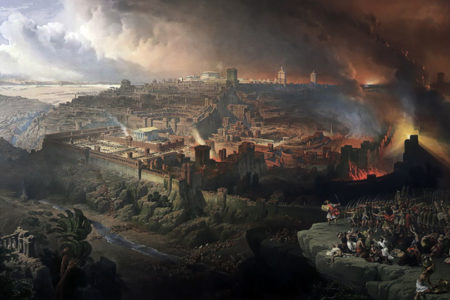The Great Tribulation: Matthew 24:9–26
Torrents of tribulation have been part and parcel of the human experience since Adam decided to take a bite out of the forbidden fruit in the Garden of Eden. Until this day, with increasing frequency, people in various parts of the world are left reeling by convulsions of nature for which they are totally unprepared. The recent earthquake in California is a prime example of such an occurrence. In a matter of seconds, a large area was so shaken that even veterans of the region’s tremors and quakes were left dazed and awestricken by the incredible destructive power unleashed upon them from deep within the earth. The tribulation recorded in Matthew 24, however, makes anything witnessed heretofore on the planet seem like a minor disruption.
Conditions during the first three and one-half years of Daniel’s 70th week are described in verses 5 to 14 and in a parallel passage in Revelation 6. As the “beginning of sorrows” period (Mt. 24:8) comes to a close, the world will be ushered into the anteroom of the Great Tribulation. A comment by A.C. Gaebelein depicts the general flavor of the time: “Disorder reigns supreme … A vast civil and political chaos will be created. What an awful scene to contemplate! A world without a magistrate.” It is precisely such a climate that will enhance the ability of the Antichrist to embellish his dominant position in the Western world and embolden him to initiate the event that will mark the beginning of the Great Tribulation—“the abomination of desolation”: “When ye, therefore, shall see the abomination of desolation, spoken of by Daniel the prophet, stand in the holy place … Then let them who are in Judea flee into the mountains” (Mt. 24:15–16).
Introduction of the infamous abomination of desolation immediately confirms at least three elements that are essential to understanding the essence of what is being taught in Matthew 24. We first learn that this portion of Scripture is related to the Jewish people and their progression toward an appointed meeting with the Messiah. The Jews of Judea are specifically addressed in the warning to flee when the abomination is erected. Second, there is a particular location in view. The abomination of desolation will stand in the “holy place”—that is, in the Tribulation Temple on Mount Moriah in the city of Jerusalem. Finally, we learn from verse 21 that the manifestation of the abomination will initiate “great tribulation, such as was not since the beginning of the world to this time, no, nor ever shall be.” This declaration puts to rest the erroneous teaching that the events described in Matthew 24 were historically fulfilled at the destruction of Jerusalem by the Romans in AD 70.
These facts also confirm basic tenets of the prophetic program set forth in Daniel (9:24–27). The 70 prophetic weeks relate primarily to Daniel’s people, the Jews, and the city of Jerusalem. Furthermore, Daniel 9:27 is directly linked to Matthew 24:15, identifying the precise time when the Antichrist will break his covenant with Israel and declare himself to be not simply a political leader but God Himself: “And he shall confirm the covenant with many for one week; and in the midst of the week he shall cause the sacrifice and the oblation to cease, and for the overspreading of abominations he shall make it desolate.”
That Israel is a central figure in the revelation of both Daniel and Matthew helps us grasp a fundamental purpose of the Great Tribulation: It is “the time of Jacob’s trouble”: “Alas! for that day is great, so that none is like it; it is even the time of Jacob’s trouble, but he shall be saved out of it” (Jer. 30:7). Thus, the reconciliation of Israel to the Messiah is a consuming objective of the final chapter in the history of God’s program for Israel and the Jewish people before the dawn of the Millennium.
The Abomination of Desolation
Just what does the Scripture mean when it speaks of “the abomination of desolation”? Daniel tells us that it will be manifested at the midpoint of the Tribulation period. Second Thessalonians 2 provides vivid detail about what will take place when “the son of perdition” (2 Th. 2:3) enters the Temple in Jerusalem. The Antichrist “opposite and exalteth himself above all that is called God, or that is worshipped, so that he, as God, sitteth in the temple of God, showing himself that he is God” (2 Th. 2:4). The unmasking of the Antichrist’s true objective reflects what Daniel 11:37 declared centuries ago: “Neither shall he regard the gods of his fathers, nor the desire of women, nor regard any god; for he shall magnify himself above all.” Satan’s grand scheme throughout the ages is to be the ultimate imitator of God (Isa. 14:12–17). With the declaration of deity by the Antichrist, he will execute his first purpose in the program to displace Christ, dethrone the Father, and install himself as lord of the universe.
The response of a credulous world is set forth in Revelation 13: “And they worshipped the dragon who gave power unto the beast; and they worshipped the beast, saying, Who is like the beast? Who is able to make war with him? … And all that dwell upon the earth shall worship him, whose names are not written in the book of life of the Lamb slain from the foundation of the world” (Rev. 13:4, 8).
To further certify the credentials of the Antichrist before a world with an insatiable appetite for “wonders” (Rev. 13:13), “miracles” (Rev. 13:14), and spectacular activity, “an image to the beast” will be set up (Rev. 13:14). This image, which may be a statue of the Antichrist himself, will evidently be animated in such a way as to give the appearance of a living being. A bow down or die decree will produce the most blasphemous appeal to practice idolatry in humanity’s history. Hard on the heels of the Matthew 24:15 word about the entrance of the abomination of desolation comes the warning for Jews of the period to flee the city immediately (Mt. 24:16–20). So extreme will be the necessity for a hasty departure that they are told, “Neither let him who is in the field return back to take his clothes” (v. 18). This word is obviously given in relationship to Israel’s response to the demand to bow to the image of the beast. If there is one thing Jewry has been able to recognize over the centuries, it is to avoid the worship of idols. So when, as with the three Hebrew children of Daniel’s day, all eyes are upon Jerusalem’s Jews to see how they react to the Antichrist’s declaration of deity and the call to bow before the image of their former political leader, their refusal to bow will become the sounding bell for the last holocaust.
All of this brings us to an interesting point over which to pause for a bit of speculation. Today people frequently raise questions about the timing of the building of a new Temple in Jerusalem, particularly since Orthodox groups in Israel have begun preparing to reinstitute Temple worship. The timing of the construction is not revealed in the Scriptures. All we are told definitively is that during the Great Tribulation there will be a Temple in Jerusalem.
If—and it may well be—the Antichrist grants permission, under his protection, for the Temple to be built (such a theory does not seem so far fetched when we realize that some of the principal allies opposing the Antichrist at the time of the Russian invasion (Ezek. 38:5–6) will be Muslim countries), the Antichrist may, as did Herod of old, himself contribute toward the construction. His interest would initially be seen as an act of benevolence toward Israel and the Jewish people. In actuality, however, he would be sanctioning the building of a Temple for himself, not for the worship of the true God! The very building of the Jews’ revered Temple would therefore create circumstances contributing to Satan’s attempt to destroy them.
The Great Tribulation
“For then shall be great tribulation, such as was not since the beginning of the world to this time, no, nor ever shall be. And except those days should be shortened, there should no flesh be saved” (Mt. 24:21–22).
Perhaps the word that best describes the final phase of the coming Tribulation is intensity. The trumpet and bowl judgments described in Revelation 8 through 16 will be marked by accelerating intensity. John Walvoord, referring to the trumpet judgments of chapter 8, says, “The effect is a grand crescendo which indicates that each judgment will come with increased severity and rapidity in the time just before the Second Coming.” The trumpets will sound judgment upon the earth (Rev. 8:7), the sea (Rev. 8:8–9), the waters (Rev. 8:10–11), the heavens (Rev. 8:12–13), and mankind (Rev. 9:1–21). These judgments will be severe but limited in scope. A third part of the earth will be burned, with its trees and grass; a third of the sea creatures and ships will be destroyed; a third of the heavenly bodies will be smitten; and a third of mankind will be wiped out by a demonic host or a demon-possessed human army.
The bowl judgments of chapter 16 seem to be not only greater in intensity but also more extensive, engulfing the entire earth. Instructions to the angels charged with pouring out the bowls have an ominous ring: “Go your ways, and pour out the bowls of the wrath of God upon the earth” (v. 1). The first bowl judgment will afflict all “men who had the mark of the beast, and upon them who worshipped his image” (v. 2); and “every living soul died in the sea” under the wrath poured out by the second angel (v. 3). The catastrophic bowl judgments will intensify until the sixth bowl (vv. 12–16) to be poured out dries up the great river Euphrates to prepare a way for the massive armies of the “kings of the east” to invade the Promised Land. In the same sequence we read of “spirits of demons, working miracles, that go forth unto the kings of the earth and of the whole world, to gather them to the battle of that great day of God Almighty … And he gathered them together into a place called in the Hebrew tongue Armageddon” (vv. 14, 16). Thus the world will be brought to the threshold of the final confrontation with its maker.
Two striking issues are evident throughout the Great Tribulation. While God’s wrath is poured out, there will be a frenzy of Satanic and demonic activity that will intensify as the period progresses. Some striking examples can be cited. Satan will “make war” against God’s two pillars of witness (Rev. 11:7). In Revelation 12 Satan attempts to destroy Israel and its people in a last, violent holocaust. An evil trinity—the Dragon (Satan), the beast out of the sea (the Antichrist), and the beast out of the earth (the false prophet)—is exposed in Revelation 13. These intriguing verses lay bare the centerpiece of Satan’s grand design—his answer to the trinity. And finally, Satan and the Antichrist will dispatch demon spirits to woo the kings of the earth to the last battle—Armageddon (Rev. 16:13–16).
But perhaps the most revealing feature of the period is humanity’s general reaction to God’s wrath and Satan’s malignant excursions. Yes, thankfully, a multitude of people will be saved during the time of the Tribulation. Revelation 7:9 to 17 describes “a great multitude, which no man could number, of all nations, and kindreds, and peoples, and tongues … who came out of the great tribulation, and have washed their robes, and made them white in the blood of the Lamb” (vv. 9, 14). These Tribulation saints, through martyrdom, will constantly enter the company of their companions in the faith “before the throne of God” (v. 15). But while this is true, the depravity of man, in the face of the most obvious witnesses to God’s message and manifestations of His wrath, will be seen in a mind-boggling display of rebellion. One illustration will serve to confirm this dreadful fact. When the seventh and final bowl of God’s wrath is poured out (Rev. 16:17–21), those who previously had “gnawed their tongues for pain, And blasphemed the God of heaven because of their pains and their sores, and repented not of their deeds” (Rev. 16:10–11) were even farther from God and more entrenched in their rebellion. In the throes of an “earthquake, such as was not since men were upon the earth” (Rev. 16:18) and bombarded by “great hail out of heaven, every stone about the weight of a talent [approximately 100 pounds] … men blasphemed God because of the plague of the hail” (Rev. 16:21). Hard to believe? Certainly. But we encounter the same blind rebellion even in this day of unparalleled grace and mercy. So, in spite of all the Lord can or will do—whether love, mercy, grace, or wrath-depraved humanity, for the most part, will continue to serve rebellion and iniquity.
The Good News
As incredible as it may seem, in view of the dark dimensions of the Great Tribulation, we should be reminded that it is, after all, an orderly and objective process that will move toward a glorious conclusion. And even while “the time of Jacob’s trouble” unfolds, there is good news for the people engulfed by thunderous judgments, marching armies, demonic belligerence, and the Antichrist’s reign of terror.
First, there is word that the period will be shortened: “And except those days should be shortened, there should no flesh be saved; but for the elect’s sake those days shall be shortened” (Mt. 24:22). The shortening of days does not refer to making the three and one-half year Great Tribulation of less duration. It does mean that unless it is limited to the allotted time, no flesh will survive. God’s purposes will be accomplished within the stated time. Believers of the period will be comforted by this fact.
Also, Jewish people who believe and Gentile Tribulation saints will have the Word of God to provide discernment, guidance, and comfort. Matthew 24, for example, will clearly warn them against the wiles of miracle-working false prophets and christs and the Antichrist himself. And it is not unreasonable to say that even literature such as you are reading at this moment may well be at hand to shed light on the issues of those dark days.
There will be salvation for those—Jew and Gentile—who will believe. We have already alluded to the Tribulation saints spoken of in Revelation 7. Matthew 24:13 informs us that “he that shall endure unto the end, the same shall be saved.” While this relates to those believers who are alive at the end of the Great Tribulation and the promise that they will then be ushered into the Kingdom, there is the triumphant word of salvation and deliverance from earth’s darkest hour.
Finally, the good news of the gospel of the Kingdom will be faithfully proclaimed: “And this gospel of the kingdom shall be preached in all the world for a witness unto all nations; and then shall the end come” (Mt. 24:14). We believe that the primary bearers of the good tidings will be the 144,000 Jewish faithful, chosen and preserved by God and identified in Revelation 7:1 to 8. As end-time John the Baptists, these select saints will preach salvation and the coming Kingdom that was set aside when the Messiah was rejected. Their news will be the best news of all: The King is coming!








